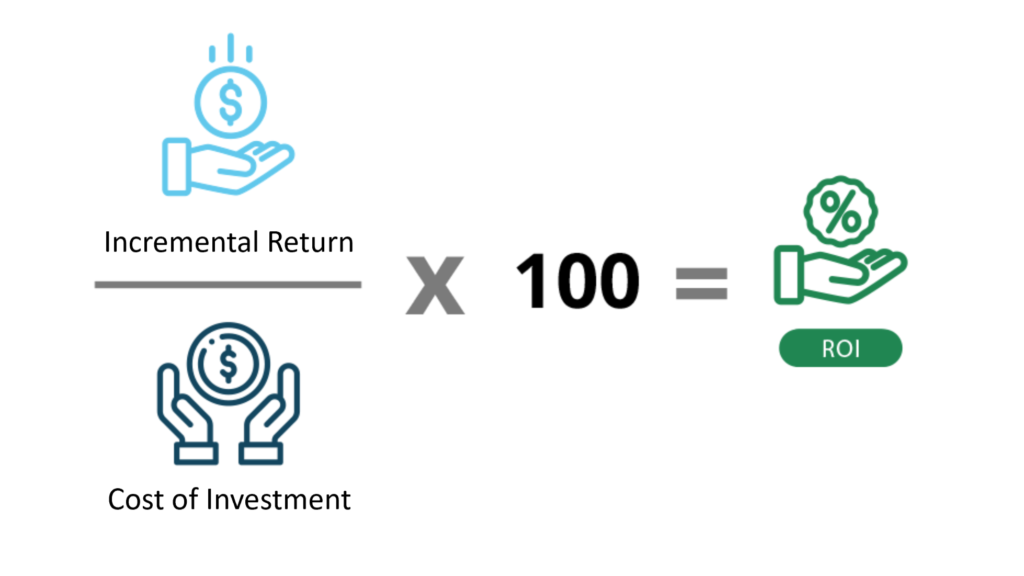In the technological world of 2021, your organization is likely using some form of technology to keep track of your costs, revenue, profit, cash flow, and about a hundred other numbers. With so many metrics to track, you’ll probably want to make a run for it (or close this tab!) at the thought of adding one more metric to the list. Give us a chance… and stick with us, because The ROI of Customer Experience which is mindfully allocated dollars and measures around your Customer Experience initiatives will have a lasting and positive impact on your business. Guaranteed.
- Customer-centric companies are 60% more profitable than companies that don’t focus on their customers.
- The revenues of Customer Experience leaders have consistently outgrown the revenues of their CX laggard competitors by a ratio of 5:1.
- 84% of companies that work to improve their Customer Experience report an increase in their revenue.
Whether these statistics are new or familiar to you, the one thing that hasn’t changed is the immense impact that a customer-centric focus can have on an organization’s bottom line. So why is it then, that many companies don’t formally allocate resources (e.g. funds, effort, and time) towards CX? When compared to more traditional streams like sales and marketing, CX is often viewed as a “softer” part of the organization that organically evolves; yet this aspect of your organization needs to be consciously supported. While the ROI made in sales and marketing campaigns, when done right, can be directly linked to revenue growth and customer acquisition, the impacts of customer satisfaction or customer loyalty don’t seem quite as simple.
In this article, we’ll delve into the standard ROI calculation, how CX impacts an organization’s bottom line, and how companies can measure amazing customer experiences and translate these efforts into a quantifiable return on their investments.
ROI Basics
Return on investment helps you understand a key component of business planning that we like to refer to as, “is the juice worth the squeeze?” In this case the squeeze is the time and financial investment you put into a product or service, and the juice is the value or financial return. When you look at your products and services this way, it’s much easier to see which investments of time and capital are profitable, and which ones may require further assessment.
We’re not saying everything you do must have a huge ROI (we’ll get into why some CX initiatives may have low ROI to transition customers into higher ROI activities in a moment), but it’s another tool in your decision-making toolkit that will help you make strategic choices about where to invest your finite resources to create a great experience for your customers, while avoiding money pits.
Although return on investment may sound like complicated business jargon, we promise you it’s quite simple. We’ve included a visual of the mathematical formula for the data nerds in the crowd to calculate the ROI percentage, but to put it simply, it’s the ratio between how much you spent on an initiative or asset and how much you received in return.

Ideally, this comparison will return a positive number (e.g. I spent $200 on a social media ad and received $2,500 of sales in return). But, sometimes this comparison helps you realize an initiative or activity is resulting in a loss for your business (e.g. I spent $200 on a social media ad and received $100 in sales in return).
Let’s use a couple slightly more exciting examples:
- A local brunch spot sells mimosa for $2 because “that’s what they cost to make.” Their philosophy is to let customers treat themselves to an extra drink or two, without the added stress of dealing with the broken dishes, irritated staff, and table hoarders that often come along with bottomless mimosas. While this philosophy may not translate to direct sales, it is a feature that will keep people coming back week after week.
- A neighbourhood pub is a local favourite, not because they sell the best beer, but because they offer free signature roasted nuts, house-made chips, or truffle popcorn with their beverages. This pub recognizes that while they are offering high-quality snacks at a loss, the customers perceive the free snacks as an added bonus to their outing, which keeps them coming back. On top of that, the salty snacks often make customers thirsty, which ultimately increases the bar’s sale of beverages.
So how does Customer experience actually impact my bottom line?
The goal of any investment or expense to your organization is to increase your profit, CX investments included. The bottom line of every business model is how profitable it is!
Below are three ways CX impacts your bottom line:
- Builds long-term customers: Customer lifetime value represents the total amount of money a customer is expected to spend on your organization throughout their lifetime. A customer with a high customer lifetime value and high loyalty increases your bottom line and ultimately leads to long term financial gains for your organization. With loyal customers five times more likely to purchase again, it is crucial to invest in, and nurture long-term relationships with your customers.
- Lowers your customer acquisition cost: Customers tell an average of nine people about a positive customer experience, which means that by providing one great experience, you’re spending zero extra dollars to market to other potential customers. By consistently providing exceptional experiences, your customers will become your raving fans and you’ll find that you’ll have to spend less marketing dollars on acquiring new customers. Needless to say, lowering your customer acquisition cost and increasing your revenue with new customers bumps up your bottom line. That’s a win-win if you ask us!
- Proactively prevents the cost of poor experience: When a customer is unhappy, they are more than likely to take their business elsewhere and on average, it takes 12 positive customer experiences to make up for 1 negative experience. If you do want to regain their business, you have to spend both time and resources to rebuild their goodwill and trust in your brand. This additional cost must then also be extended to include the friends with whom the disgruntled customer has shared their experience with, and/or the thousands of people who have read their negative review online. The point is, instead of spending resources recovering from poor experiences, investing these resources in a great CX the first time around will save you big $$ in the long run.
By starting with a few of the small actions outlined below, you’ll be increasing your bottom line, quantifying financial impacts of investments, and most importantly, your customers will notice your genuine care for them and become your raving fans.
How Can You Calculate the ROI for Your Customer Experience Investments?
With CX investments, it can sometimes be trickier to tie investment to a direct return, but there are simple ways to track the return on CX investments without jumping into Excel and building a financial model for every customer interaction. Many organizations have coined a new metric, return on experience (ROX), which measures across the company to find correlations between investments and any decisive influence on the customer and employee experience. By capturing a few numbers and doing a few calculations to track your CX, you can begin to critically analyze your customer investments, focus on the incremental dollars of change, and refine your CX strategy.
Try it yourself! Adopt one (or all) of these activities to start tracking how CX is impacting your bottom line:
1. Manage by Metrics
Created by Bain & Company, net promoter score (NPS) is the most popular customer metric used by companies globally and asks customers only one question: “On a scale of 0 to 10, how likely are you to recommend our product to a friend or colleague?” Customers can be segregated into three categories based on their answer:
- 0-6 = Detractors – unhappy customers who hurt your brand through negative word-of-mouth
- 7-8 = Passives – satisfied but indifferent customers who could be swayed by competitors
- 9-10 = Promoters – loyal customers who will keep buying and referring others
Tracking whether the ratio of promoters to detractors increases or decreases over time gives organizations a good indication of whether their CX is improving, worsening, or remaining stagnant. By tracking the incremental changes to your revenue along with your NPS, you can measure this change against the cost of your investment to understand whether the ROI of your CX investment is positive or negative. Quantifying the impact of CX doesn’t have to be complicated!
2. Measure your Investments
The easiest way to measure your spending is to develop a specific line item in your budget and a plan for your CX investments. Whether these investments are initiatives for more personalized marketing, or improvements to the product or service itself, knowing exactly how much you’re spending on your CX allows for more accurate attribution of changes in revenue to specific investments. Furthermore, by tracking the ROI of different investments, you’ll have visibility as to which investments provide the greatest return and be able to streamline your CX spending.
For example, if your restaurant is located on a busy street, parking may be a pain point for your customers. You have two potential solutions – you could pay the city to reserve the 5 spots in front of your restaurant, or you could hire a food delivery company and offer free delivery for your customers. By piloting both solutions and measuring the costs and revenues within the pilot periods, you’ll have accurate profitability data that can help inform your decision.
3. Set a Time Frame
ROI can be incredibly useful when comparing the success of investments, however, it is important to consider the expected waiting periods before the return is realized. For example, when you hold a weekend-long buy-one-get-one deal, you know by the end of the weekend what your costs and returns were. But when you think of longer-term promotions like a free birthday gift or digital point redemption, you’ll need to set different timeframes to see the full cost of the program. You may have a rush of July babies followed by only a handful of fall birthdays, or customers might wait months to collect and redeem points instead of immediately cashing in.
Going back to Action 2 above, it is important to set a time frame for your CX budget and plan and measure results quarterly, semi-annually, or annually. Setting a time frame allows you to accurately compare the trends behind the returns of multiple investments and hedges the risk of longer-term investments by allowing you to incrementally evaluate progress.
Closing Thoughts
If you’ve been following along with our other blog posts, there’s no denying that customer expectations have risen and CX has quickly become the biggest competitive differentiator. A problem that many larger organizations face comes with conveying a quantifiable financial impact to the C-Suite Executives who perceive CX as a “soft” investment. The key to getting executives on board is to prove that CX spending improves the organization’s bottom line and to tie the CX spending into an area where the organization is already investing. Relating the CX expenditures, efforts, and returns to an existing strategic initiative tells a numerical story that allows executives to understand the potential of CX spending at an organizational level.
Not sure how to take your Customer Experience to the next level and looking for a little extra help? At the XLAB, we work with bold leaders who aren’t afraid to lead a change to create amazing experiences for their customers. Visit Stack’d XLABS for more information on how we can work together to accelerate your customer experience.



